Advancing Smart City Sustainability Through Artificial Intelligence, Digital Twin and Blockchain Solutions
Abstract
1. Introduction
2. Related Work
- Data extraction: Machine learning algorithms can automatically identify key information from large and diverse data sources, including text documents, Internet of Things (IoT) devices, and social networks. Automating this step reduces the time required for data collection and increases process reliability [16,29].
- Data transformation: Algorithms such as clustering and deviation analysis can recognize irregularities in data and automatically correct them, thereby improving data quality and standardization of data from heterogeneous sources [30]. Prediction of missing values by techniques such as regression allows filling in missing data based on existing patterns, reducing the need for manual data entry or discarding.
- Data loading: By optimizing performance, machine learning algorithms can predict optimal time intervals for loading large amounts of data, ensuring minimal system load and faster processing [6,31]. Continuous updating and synchronization of data is enabled, which is crucial for applications that require updated information in real time [16].
3. Integrated Digital Twin and Blockchain Architecture for Smart City Transformation
3.1. Business Intelligence Model and Digital Twin
- Increasing competitiveness: Using advanced machine learning algorithms in the ETL process enables more accurate data analysis. Users are provided with an insight into market trends, optimized business processes, and a better strategy, which achieves a competitive advantage on a global level [46].
- Digital business transformation: Integrating business intelligence in the cloud allows SMEs to modernize and migrate business processes to digital platforms by connecting them with blockchain technology to ensure data transparency and security, which is key to digital transformation in industries such as finance [47,48], healthcare [49], or retail [50].
- Increased security and trust: Blockchain networks offer a high level of security and transparency, which allows for easier verification of data and transactions. This increases trust among partners, customers, and regulators, which is key to the global competitiveness of SMEs.
- Scalability and flexibility: A cloud solution enables scalability, which means it can grow with the business while reducing the need for large initial infrastructure investments. It also uses the flexibility that clouds offer in terms of speed of implementation and adaptability to market changes [51,52].
- Optimizing business decisions: The use of business intelligence enables faster making of informed decisions based on data. With the help of advanced analytics and machine-based recommendations, Smart City companies can better understand market opportunities, reduce risks, and optimize resources, thus increasing their efficiency and reducing costs [53].
- Monitor and analyze the performance of assets and systems in real time, detecting inefficiencies or faults as they arise.
- Run simulations and scenario analyses to predict the outcomes of changes, optimize operations, and support data-driven decision making.
- Test new designs, policies, or interventions virtually before implementing them in the physical environment, reducing risk and costs.
- Enable predictive maintenance and proactive resource management, improving operational efficiency and reducing downtime.
- Foster transparency and participatory governance by providing stakeholders—including citizens—with access to real-time data and interactive dashboards.
- Support sustainability goals by optimizing resource usage, reducing emissions, and enhancing overall system performance.
3.2. Private Blockchain Network
3.3. Specific Model Requirements for Business Intelligence Applications
- Structured and unstructured data that are collected from various sources during the ETL process.
- Transformed data that is aggregated, normalized, and cleaned data ready for analytics.
- Metadata with information about the source, quality, and status of the data.
- ○
- Data quality metrics are often stored to monitor the accuracy, consistency, completeness, and timeliness of data. This data can include information about missing values, data irregularities, or input errors.
- ○
- Indexing is important for optimizing queries in data warehouses, enabling faster access to large amounts of data. Indexes help speed up data analysis, especially when the data is very voluminous.
- ○
- Data versioning can be stored to track the evolution and changes in data over time, providing a history of all data versions for later analysis.
- ○
- The transaction data can also be stored during the ETL process to track when and how data was extracted, transformed, and loaded. This data allows for audits and the detection of potential errors or problems in the ETL process.
- ○
- Reference data can be used to standardize data coming from different sources, such as country lists, industries, currencies, or product codes. This data ensures data consistency and accuracy.
- ○
- Business rules that define data validation and transformation can be stored to ensure that all data in the warehouse meets a defined set of conditions and requirements.
- Historical data needed for analysis and prediction models.
- During the data extraction phase, the following metadata is stored in the blockchain:
- ○
- Record ID, which is a unique identifier for each data item collected.
- ○
- Information about the source of the collected data (e.g., database, IoT device, API).
- ○
- Timestamps, the exact time of extraction to ensure historical traceability.
- ○
- Content of the collected data (e.g., measurements, transactions, and user data).
- ○
- Data hash values are calculated over key data sets to ensure their integrity.
- ○
- Information about the users or applications that initiated the extraction process.
- ○
- Records of the quality and validation of the data source (e.g., size, format, or the presence of anomalies).
- During the data transformation phase, the following metadata is stored in the blockchain:
- ○
- Transformation operations—Types of changes, such as aggregation, normalization, or data cleansing.
- ○
- Data versions—The history of changes for each transformation, including the original and transformed form of the data.
- ○
- Validation rules—The criteria applied to ensure the accuracy and consistency of the data.
- ○
- Error identification—Any anomalies or errors detected in the data, and how they were handled.
- During the data loading phase, the following metadata is stored in the blockchain:
- ○
- Destinations—Locations where the data is stored (e.g., a data warehouse or analytics platform).
- ○
- Load timestamps—Precise storage of the time of each load.
- ○
- Data integrity—Controls to ensure that data has not been modified during the loading process.
- ○
- Audit trail—A transparent record of all process steps, including any adjustments or interventions.
3.4. User Interaction with the Proposed Model Using Natural Language Processing
- User data should not be stored on the platform’s central servers to preserve the privacy of user data. Instead, the data remains on the user’s computer, and the LLM Server can only access it temporarily during processing.
- By recording all user queries and the results obtained by the LLM Server in the blockchain, authentication and transparency are enabled.
- It is possible to subsequently verify the results of the query against the system: the hash of the results allows for a later verification of the accuracy of the answers given by the system to the user. This can always be checked whether the system has advised the user correctly in the event of subsequent disputes or ambiguities. A security check can be made because the blockchain allows for the tracking of each step of the process, which ensures non-repudiation because it is impossible to retroactively change the data or results without leaving a trace. Transparency of the entire process is obtained because all relevant data about the process is available for audit.
- Audit trail: Implementing an audit trail allows for the tracking of user activities, when the data was used and for what purpose, and ensures that it is authentic.
- The identifier of the user who made the query, which should be an anonymous or pseudonymous user ID.
- The timestamp of the user sending the query to the system.
- The query type, which indicates the category or type of query (e.g., prediction, trend analysis, and recommendations).
- Hash values of the data sent by the user during the data upload to the system to later used to verify the integrity of the data and ensure that it has not been tampered with.
- The query result is stored as a summary of the results, including the hash of the generated data or response.
- Audit record as a historical trace that includes all processing steps related to the query.
3.5. Comparative Analysis and Contextualization
- Data standardization and interoperability—Harmonizing data formats and integrating legacy systems remains a technical barrier [12].
- Privacy and compliance—Ensuring data protection and regulatory compliance, particularly with blockchain-based systems, is a critical concern [41].
- Scalability and generalizability—Most integrated platforms are still at the pilot stage, with further research needed to validate scalability in larger or more complex urban environments [9].
4. Developing Digital Infrastructure for Smart Cities
4.1. Implementation of a Private Blockchain Network Using the Hyperledger Besu Platform
- Validator Nodes: Four nodes operated as validators, participating in the consensus protocol. These nodes are responsible for proposing, validating, and finalizing blocks, ensuring the integrity and reliability of the network. Each validator can be managed by a distinct organization, supporting data partitioning and access control at the organizational level. The topology allows for seamless addition of new validator nodes as the network grows, enabling horizontal scalability.
- Non-Validator (Regular) Nodes: The remaining five nodes functioned as regular (non-validator) nodes. These nodes maintain a copy of the blockchain, submit transactions, interact with smart contracts, and provide Application Programming Interface (API) endpoints for client applications. While they do not participate in block validation, they ensure network robustness and facilitate connectivity for end users and applications.
- Privacy and Permissioning: Besu’s permission features were configured to restrict network participation to authorized nodes and accounts, ensuring a permissioned environment suitable for enterprise and Smart City use cases. Private transactions were enabled via integration with a privacy manager such as Tessera, allowing confidential data sharing between designated participants.
- CPU: Minimum four virtual CPUs
- Memory: At least 16 GB RAM
- Storage: SSD drives for low latency and high I/O throughput
- Docker and Docker Compose for container orchestration and deployment consistency.
- Node.js runtime environment to support various network management tools and smart contract interaction.
- The integrity and reliability of peer-to-peer communication between nodes.
- Correctness and finality of transactions as processed by the consensus protocol.
- System performance under simulated transaction loads to evaluate stability and scalability.
- Fault injection scenarios to assess the network’s tolerance to node failures or malicious activity.
- A subset of nodes was deployed on Windows OS inside Docker containers.
- Another subset operated on native Linux installations.
- The remaining nodes ran within Docker containers on Linux hosts.
4.2. Building the Foundation of a Smart City Digital Twin
5. Evaluation and Future Work
5.1. Comprehensive User Survey
5.2. Platform Adaptability and Modularity
6. Conclusions
Author Contributions
Funding
Data Availability Statement
Conflicts of Interest
Abbreviations
| AI | Artificial Intelligence |
| API | Application Programming Interface |
| BI | Business Intelligence |
| CPU | Central Processing Unit |
| ETL | Extract, Transform, Load |
| EU | European Union |
| EVM | Ethereum Virtual Machine |
| GDPR | General Data Protection Regulation |
| HIPAA | Health Insurance Portability and Accountability Act |
| IBFT | Istanbul Byzantine Fault Tolerance |
| IoT | Internet of Things |
| KPI | Key Performance Indicator |
| LSTM | Long Short-Term Memory |
| ML | Machine Learning |
| OS | Operating System |
| PKI | Public Key Infrastructure |
| PoA | Proof of Authority |
| PoW | Proof of Work |
| RAM | Random Access Memory |
| SaaS | Software as a Service |
| SME | Small and Medium-sized Enterprise |
| SSD | Solid State Drive |
| URL | Uniform Resource Locator |
References
- Adewusi, A.O.; Okoli, U.I.; Adaga, E.; Olorunsogo, T.; Asuzu, O.F.; Daraojimba, D.O. Business Intelligence in the Era of Big Data: A Review of Analytical Tools and Competitive Advantage. Comput. Sci. IT Res. J. 2024, 5, 415–431. [Google Scholar] [CrossRef]
- Hansen, M.M.; Koonsanit, K.; Kulmala, V. How Can Data Contribute to Smart City Innovation: A Study from Thailand’s Smart City Initiatives. Front. Sustain. Cities 2025, 6, 1473123. [Google Scholar] [CrossRef]
- Gudfinnsson, K.; Strand, M. Challenges with BI adoption in SMEs. In Proceedings of the 2017 8th International Conference on Information, Intelligence, Systems & Applications (IISA), Larnaca, Cyprus, 28–30 August 2017; pp. 1–6. [Google Scholar] [CrossRef]
- Nenzhelele, T.E.; Pellissier, R. Competitive Intelligence Implementation Challenges of Small and Medium-Sized Enterprises. Mediterr. J. Soc. Sci. 2014, 5, 92. [Google Scholar] [CrossRef][Green Version]
- Alsibhawi, I.A.A.; Yahaya, J.B.; Mohamed, H.B. Business Intelligence Adoption for Small and Medium Enterprises: Conceptual Framework. Appl. Sci. 2023, 13, 4121. [Google Scholar] [CrossRef]
- Tawil, A.-R.H.; Mohamed, M.; Schmoor, X.; Vlachos, K.; Haidar, D. Trends and Challenges towards Effective Data-Driven Decision Making in UK Small and Medium-Sized Enterprises: Case Studies and Lessons Learnt from the Analysis of 85 Small and Medium-Sized Enterprises. Big Data Cogn. Comput. 2024, 8, 79. [Google Scholar] [CrossRef]
- Rizzatto, M.; L’Erario, A.; De Almeida, M.E. Prototyping Smart City Solutions with Metaverse and Digital Twins: A Systematic Literature Mapping. In Proceedings of the 27th International Conference on Enterprise Information Systems, Porto, Portugal, 4–6 April 2025; SCITEPRESS—Science and Technology Publications: Porto, Portugal, 2025; pp. 193–200. [Google Scholar]
- Huang, J.; Bibri, S.E.; Keel, P. Generative Spatial Artificial Intelligence for Sustainable Smart Cities: A Pioneering Large Flow Model for Urban Digital Twin. Environ. Sci. Ecotechnol. 2025, 24, 100526. [Google Scholar] [CrossRef]
- Bibri, S.E.; Huang, J.; Jagatheesaperumal, S.K.; Krogstie, J. The Synergistic Interplay of Artificial Intelligence and Digital Twin in Environmentally Planning Sustainable Smart Cities: A Comprehensive Systematic Review. Environ. Sci. Ecotechnol. 2024, 20, 100433. [Google Scholar] [CrossRef]
- Gkontzis, A.F.; Kotsiantis, S.; Feretzakis, G.; Verykios, V.S. Enhancing Urban Resilience: Smart City Data Analyses, Forecasts, and Digital Twin Techniques at the Neighborhood Level. Future Internet 2024, 16, 47. [Google Scholar] [CrossRef]
- Aghazadeh Ardebili, A.; Zappatore, M.; Ramadan, A.I.H.A.; Longo, A.; Ficarella, A. Digital Twins of Smart Energy Systems: A Systematic Literature Review on Enablers, Design, Management and Computational Challenges. Energy Inform. 2024, 7, 94. [Google Scholar] [CrossRef]
- Regueiro, C.; Seco, I.; Gutiérrez-Agüero, I.; Urquizu, B.; Mansell, J. A Blockchain-Based Audit Trail Mechanism: Design and Implementation. Algorithms 2021, 14, 341. [Google Scholar] [CrossRef]
- Tavares, J.M.R.S.; Karri, C.; Machado, J.J.M.; Jain, D.K.; Dannana, S.; Gottapu, S.K.; Gandomi, A.H. Recent Technology Advancements in Smart City Management: A Review. Comput. Mater. Contin. 2024, 81, 3617–3663. [Google Scholar] [CrossRef]
- Biasin, M.; Delle Foglie, A. Blockchain and Smart Cities for Inclusive and Sustainable Communities: A Bibliometric and Systematic Literature Review. Sustainability 2024, 16, 6669. [Google Scholar] [CrossRef]
- Huzzat, A.; Anpalagan, A.; Khwaja, A.S.; Woungang, I.; Alnoman, A.A.; Pillai, A.S. A Comprehensive Review of Digital Twin Technologies in Smart Cities. Digit. Eng. 2025, 4, 100040. [Google Scholar] [CrossRef]
- Mondal, K.C.; Biswas, N.; Saha, S. Role of Machine Learning in ETL Automation. In Proceedings of the 21st International Conference on Distributed Computing and Networking, Kolkata, India, 4–7 January 2020; pp. 1–6. [Google Scholar]
- Mantri, A. Advanced ML (Machine Learning) Techniques for Optimizing ETL Workflows with Apache Spark and Snowflake. J. Artif. Intell. Cloud Comput. 2023, 2, 1–6. [Google Scholar] [CrossRef]
- Dinesh, L.; Devi, K.G. An Efficient Hybrid Optimization of ETL Process in Data Warehouse of Cloud Architecture. J. Cloud Comput. 2024, 13, 12. [Google Scholar] [CrossRef]
- Souibgui, M.; Atigui, F.; Zammali, S.; Cherfi, S.; Yahia, S.B. Data Quality in ETL Process: A Preliminary Study. Procedia Comput. Sci. 2019, 159, 676–687. [Google Scholar] [CrossRef]
- Zdravevski, E.; Apanowicz, C.; Stencel, K.; Slezak, D. Scalable Cloud-Based ETL for Self-Serving Analytics. In Proceedings of the Advances in Data Mining: Applications and Theoretical Aspects, New York, NY, USA, 17–21 July 2019; Springer International Publishing: Cham, Switzerland, 2019; pp. 387–394. [Google Scholar]
- Singh, M.M. Extraction Transformation and Loading (ETL) of Data Using ETL Tools. Int. J. Res. Appl. Sci. Eng. Technol. 2022, 10, 4415–4420. [Google Scholar] [CrossRef]
- Mayo, C.; Kessler, M.L.; Feng, M.; Weyburn, G.; El Naqa, I.; Eisbruch, A.; Matuszak, M.M.; McShan, D.; Moran, J.M.; Anderson, C.J.; et al. Taming Big Data: Implementation of a Clinical Use-Case Driven Architecture. Int. J. Radiat. Oncol. 2016, 96, E417–E418. [Google Scholar] [CrossRef]
- Santos, V.; Belo, O. Using Relational Algebra on the Specification of Real World ETL Processes. In Proceedings of the 2015 IEEE International Conference on Computer and Information Technology; Ubiquitous Computing and Communications; Dependable, Autonomic and Secure Computing; Pervasive Intelligence and Computing, Liverpool, UK, 26–28 October 2015; pp. 861–866. [Google Scholar]
- Zhang, X.; Wen, S.; Yan, L.; Feng, J.; Xia, Y. A Hybrid-Convolution Spatial–Temporal Recurrent Network for Traffic Flow Prediction. Comput. J. 2024, 67, 236–252. [Google Scholar] [CrossRef]
- Li, B.; Zhou, X.; Ning, Z.; Guan, X.; Yiu, K.-F.C. Dynamic Event-Triggered Security Control for Networked Control Systems with Cyber-Attacks: A Model Predictive Control Approach. Inf. Sci. 2022, 612, 384–398. [Google Scholar] [CrossRef]
- Kim, S.-S.; Lee, W.-R.; Go, J.-H. A Study on Utilization of Spatial Information in Heterogeneous System Based on Apache NiFi. In Proceedings of the 2019 International Conference on Information and Communication Technology Convergence (ICTC), Jeju Island, Republic of Korea, 16–18 October 2019; pp. 1117–1119. [Google Scholar]
- Meng, L.; McWilliams, B.; Jarosinski, W.; Park, H.-Y.; Jung, Y.-G.; Lee, J.; Zhang, J. Machine Learning in Additive Manufacturing: A Review. JOM 2020, 72, 2363–2377. [Google Scholar] [CrossRef]
- Biswas, N.; Biswas, S.; Mondal, K.C.; Maiti, S. Challenges and Solutions of Real-Time Data Integration Techniques by ETL Application: In Advances in Business Information Systems and Analytics; Darwish, D., Ed.; IGI Global: Hershey, PA, USA, 2024; pp. 348–371. ISBN 979-8-3693-0413-6. [Google Scholar]
- Castellanos, M.; Simitsis, A.; Wilkinson, K.; Dayal, U. Automating the Loading of Business Process Data Warehouses. In Proceedings of the 12th International Conference on Extending Database Technology: Advances in Database Technology, Saint Petersburg, Russia, 24–26 March 2009; pp. 612–623. [Google Scholar]
- Alak, B.; Revanbahş, A.; Argün, N.; Çalım, A.S. Anomaly Detection for ETL Packages Runtime: A Machine Learning Approach. In Proceedings of the 2023 8th International Conference on Computer Science and Engineering (UBMK), Burdur, Türkiye, 13–15 September 2023; pp. 108–113. [Google Scholar] [CrossRef]
- Cormier, K.; Gagnier, K.A.; Padron-Uy, J.; Sareen, D.; Parihar, A.; Khmelevsky, Y.; Hains, G.; Wong, A.K.S. Data Extraction, Transformation, and Loading (ETL) Process Automation and Data Warehouse Implementation for Algorithmic Trading Machine Learning Modelling. In Proceedings of the 2025 IEEE International systems Conference (SysCon), Montreal, QC, Canada, 7–10 April 2025; pp. 1–8. [Google Scholar] [CrossRef]
- Satoshi, N. Bitcoin: A Peer-to-Peer Electronic Cash System. 2008. Available online: https://bitcoin.org/bitcoin.pdf (accessed on 5 June 2025).
- Salzano, F.; Marchesi, L.; Pareschi, R.; Tonelli, R. Integrating Blockchain Technology within an Information Ecosystem. Blockchain Res. Appl. 2024, 5, 100225. [Google Scholar] [CrossRef]
- Crosby, M.; Pattanayak, P.; Verma, S.; Kalyanaraman, V. Blockchain Technology: Beyond Bitcoin. Appl. Innov. 2016, 2, 6–19. [Google Scholar]
- Dinh, T.T.A.; Wang, J.; Chen, G.; Liu, R.; Ooi, B.C.; Tan, K.-L. BLOCKBENCH: A Framework for Analyzing Private Blockchains. In Proceedings of the 2017 ACM International Conference on Management of Data, Chicago, IL, USA, 14–19 May 2017; pp. 1085–1100. [Google Scholar]
- Dinh, T.T.A.; Liu, R.; Zhang, M.; Chen, G.; Ooi, B.C.; Wang, J. Untangling Blockchain: A Data Processing View of Blockchain Systems. IEEE Trans. Knowl. Data Eng. 2018, 30, 1366–1385. [Google Scholar] [CrossRef]
- Francisco, K.; Swanson, D. The Supply Chain Has No Clothes: Technology Adoption of Blockchain for Supply Chain Transparency. Logistics 2018, 2, 2. [Google Scholar] [CrossRef]
- Marijan, D.; Lal, C. Blockchain Verification and Validation: Techniques, Challenges, and Research Directions. Comput. Sci. Rev. 2022, 45, 100492. [Google Scholar] [CrossRef]
- Ullah, F.; He, J.; Zhu, N.; Wajahat, A.; Nazir, A.; Qureshi, S.; Pathan, M.S.; Dev, S. Blockchain-Enabled EHR Access Auditing: Enhancing Healthcare Data Security. Heliyon 2024, 10, e34407. [Google Scholar] [CrossRef]
- Drummer, D.; Neumann, D. Is Code Law? Current Legal and Technical Adoption Issues and Remedies for Blockchain-Enabled Smart Contracts. J. Inf. Technol. 2020, 35, 337–360. [Google Scholar] [CrossRef]
- Asif, M.; Aziz, Z.; Bin Ahmad, M.; Khalid, A.; Waris, H.A.; Gilani, A. Blockchain-Based Authentication and Trust Management Mechanism for Smart Cities. Sensors 2022, 22, 2604. [Google Scholar] [CrossRef]
- Mollajafari, S.; Bechkoum, K. Blockchain Technology and Related Security Risks: Towards a Seven-Layer Perspective and Taxonomy. Sustainability 2023, 15, 13401. [Google Scholar] [CrossRef]
- Puthal, D.; Mohanty, S.P. Proof of Authentication: IoT-Friendly Blockchains. IEEE Potentials 2019, 38, 26–29. [Google Scholar] [CrossRef]
- Alkhateeb, A.; Catal, C.; Kar, G.; Mishra, A. Hybrid Blockchain Platforms for the Internet of Things (IoT): A Systematic Literature Review. Sensors 2022, 22, 1304. [Google Scholar] [CrossRef] [PubMed]
- Le, T.-V.; Hsu, C.-L.; Chen, W.-X. A Hybrid Blockchain-Based Log Management Scheme with Nonrepudiation for Smart Grids. IEEE Trans. Ind. Inform. 2022, 18, 5771–5782. [Google Scholar] [CrossRef]
- Gao, H.; Kou, G.; Liang, H.; Zhang, H.; Chao, X.; Li, C.-C.; Dong, Y. Machine Learning in Business and Finance: A Literature Review and Research Opportunities. Financ. Innov. 2024, 10, 86. [Google Scholar] [CrossRef]
- Javaid, M.; Haleem, A.; Singh, R.P.; Suman, R.; Khan, S. A Review of Blockchain Technology Applications for Financial Services. BenchCouncil Trans. Benchmarks Stand. Eval. 2022, 2, 100073. [Google Scholar] [CrossRef]
- Sharma, J. Blockchain Technology Adoption in Financial Services: Opportunities and Challenges. In Advances in Finance, Accounting, and Economics; Mehta, K., Sharma, R., Yu, P., Eds.; IGI Global: Hershey, PA, USA, 2023; pp. 99–117. ISBN 978-1-6684-8624-5. [Google Scholar]
- Khezr, S.; Moniruzzaman, M.; Yassine, A.; Benlamri, R. Blockchain Technology in Healthcare: A Comprehensive Review and Directions for Future Research. Appl. Sci. 2019, 9, 1736. [Google Scholar] [CrossRef]
- Xu, P.; Lee, J.; Barth, J.R.; Richey, R.G. Blockchain as Supply Chain Technology: Considering Transparency and Security. Int. J. Phys. Distrib. Logist. Manag. 2021, 51, 305–324. [Google Scholar] [CrossRef]
- Sengar, R. The Changing Business Prospective with Cloud Computing: A Review. SSRN Electron. J. 2023. [Google Scholar] [CrossRef]
- Dziembek, D.; Ziora, L. Cloud-Based Business Intelligence Solutions in the Management of Polish Companies. In Advances in Information Systems Development; Silaghi, G.C., Buchmann, R.A., Niculescu, V., Czibula, G., Barry, C., Lang, M., Linger, H., Schneider, C., Eds.; Lecture Notes in Information Systems and Organisation; Springer International Publishing: Cham, Switzerland, 2023; Volume 63, pp. 35–52. ISBN 978-3-031-32417-8. [Google Scholar]
- Rane, N.L.; Paramesha, M.; Choudhary, S.P.; Rane, J. Artificial Intelligence, Machine Learning, and Deep Learning for Advanced Business Strategies: A Review. Partn. Univers. Int. Innov. J. 2024, 2, 147–171. [Google Scholar] [CrossRef]
- González-Varona, J.; López-Paredes, A.; Poza, D.; Acebes, F. Building and Development of an Organizational Competence for Digital Transformation in SMEs. J. Ind. Eng. Manag. 2021, 14, 15. [Google Scholar] [CrossRef]
- Tern, S. Survey of Smart Contract Technology and Application Based on Blockchain. Open J. Appl. Sci. 2021, 11, 1135–1148. [Google Scholar] [CrossRef]
- Androulaki, E.; Barger, A.; Bortnikov, V.; Cachin, C.; Christidis, K.; De Caro, A.; Enyeart, D.; Ferris, C.; Laventman, G.; Manevich, Y.; et al. Hyperledger Fabric: A Distributed Operating System for Permissioned Blockchains. In Proceedings of the Thirteenth EuroSys Conference, Porto, Portugal, 23–26 April 2018; pp. 1–15. [Google Scholar]
- Han, H.; Shiwakoti, R.K.; Chen, W. Unlocking Enterprise Blockchain Adoption: A R3 Corda Case Study. J. Gen. Manag. 2024, 03063070241292701. [Google Scholar] [CrossRef]
- Baliga, A.; Subhod, I.; Kamat, P.; Chatterjee, S. Performance Evaluation of the Quorum Blockchain Platform. arXiv 2018, arXiv:1809.03421. [Google Scholar]
- Shahrukh, M.d.R.H.; Rahman, M.d.T.; Mansoor, N. Exploration of Hyperledger Besu in Designing Private Blockchain-Based Financial Distribution Systems. arXiv 2023, arXiv:2311.08483. [Google Scholar]
- Švarcmajer, M.; Ivanović, D.; Rudec, T.; Lukić, I. Application of Graph Theory and Variants of Greedy Graph Coloring Algorithms for Optimization of Distributed Peer-to-Peer Blockchain Networks. Technologies 2025, 13, 33. [Google Scholar] [CrossRef]
- Serena, L.; D’Angelo, G.; Ferretti, S. Security Analysis of Distributed Ledgers and Blockchains through Agent-Based Simulation. Simul. Model. Pract. Theory 2022, 114, 102413. [Google Scholar] [CrossRef]
- Fedotov, I.; Khritankov, A. Statistical Model Checking of Common Attack Scenarios on Blockchain. arXiv 2021, arXiv:2109.02803. [Google Scholar] [CrossRef]
- Zohar, A. Bitcoin: Under the Hood. Commun. ACM 2015, 58, 104–113. [Google Scholar] [CrossRef]
- Vassiliadis, P. A Survey of Extract–Transform–Load Technology. Int. J. Data Warehous. Min. 2009, 5, 1–27. [Google Scholar] [CrossRef]
- Herath, H.M.K.K.M.B.; Mittal, M. Adoption of Artificial Intelligence in Smart Cities: A Comprehensive Review. Int. J. Inf. Manag. Data Insights 2022, 2, 100076. [Google Scholar] [CrossRef]
- Mrabet, M.; Sliti, M. Integrating Machine Learning for the Sustainable Development of Smart Cities. Front. Sustain. Cities 2024, 6, 1449404. [Google Scholar] [CrossRef]
- Dani, A.A.H.; Supangkat, S.H.; Lubis, F.F.; Nugraha, I.G.B.B.; Kinanda, R.; Rizkia, I. Development of a Smart City Platform Based on Digital Twin Technology for Monitoring and Supporting Decision-Making. Sustainability 2023, 15, 14002. [Google Scholar] [CrossRef]
- Oyinloye, D.P.; Teh, J.S.; Jamil, N.; Alawida, M. Blockchain Consensus: An Overview of Alternative Protocols. Symmetry 2021, 13, 1363. [Google Scholar] [CrossRef]
- Addas, A.; Khan, M.N.; Naseer, F. Waste Management 2.0 Leveraging Internet of Things for an Efficient and Eco-Friendly Smart City Solution. PLoS ONE 2024, 19, e0307608. [Google Scholar] [CrossRef] [PubMed]
- Kuzhin, M.F.; Joshi, A.; Mittal, V.; Khatkar, M.; Guven, U. Optimizing Waste Management through IoT and Analytics: A Case Study Using the Waste Management Optimization Test. BIO Web Conf. 2024, 86, 01090. [Google Scholar] [CrossRef]
- Serrano, M.; Griffor, E.; Wollman, D.; Dunaway, M.; Burns, M.; Rhee, S.; Greer, C. Smart Cities and Communities: A Key Performance Indicators Framework; National Institute of Standards and Technology: Gaithersburg, MD, USA, 2022; p. NIST SP 190-206. [Google Scholar]
- Tang, Z.; Zhuang, D.; Zhang, J. Evaluation Framework for Domain-Specific Digital Twin Platforms. Sci. Rep. 2025, 15, 10544. [Google Scholar] [CrossRef]
- Alamri, B.; Crowley, K.; Richardson, I. Cybersecurity Risk Management Framework for Blockchain Identity Management Systems in Health IoT. Sensors 2022, 23, 218. [Google Scholar] [CrossRef]
- Zafar, A. Reconciling Blockchain Technology and Data Protection Laws: Regulatory Challenges, Technical Solutions, and Practical Pathways. J. Cybersecur. 2025, 11, tyaf002. [Google Scholar] [CrossRef]
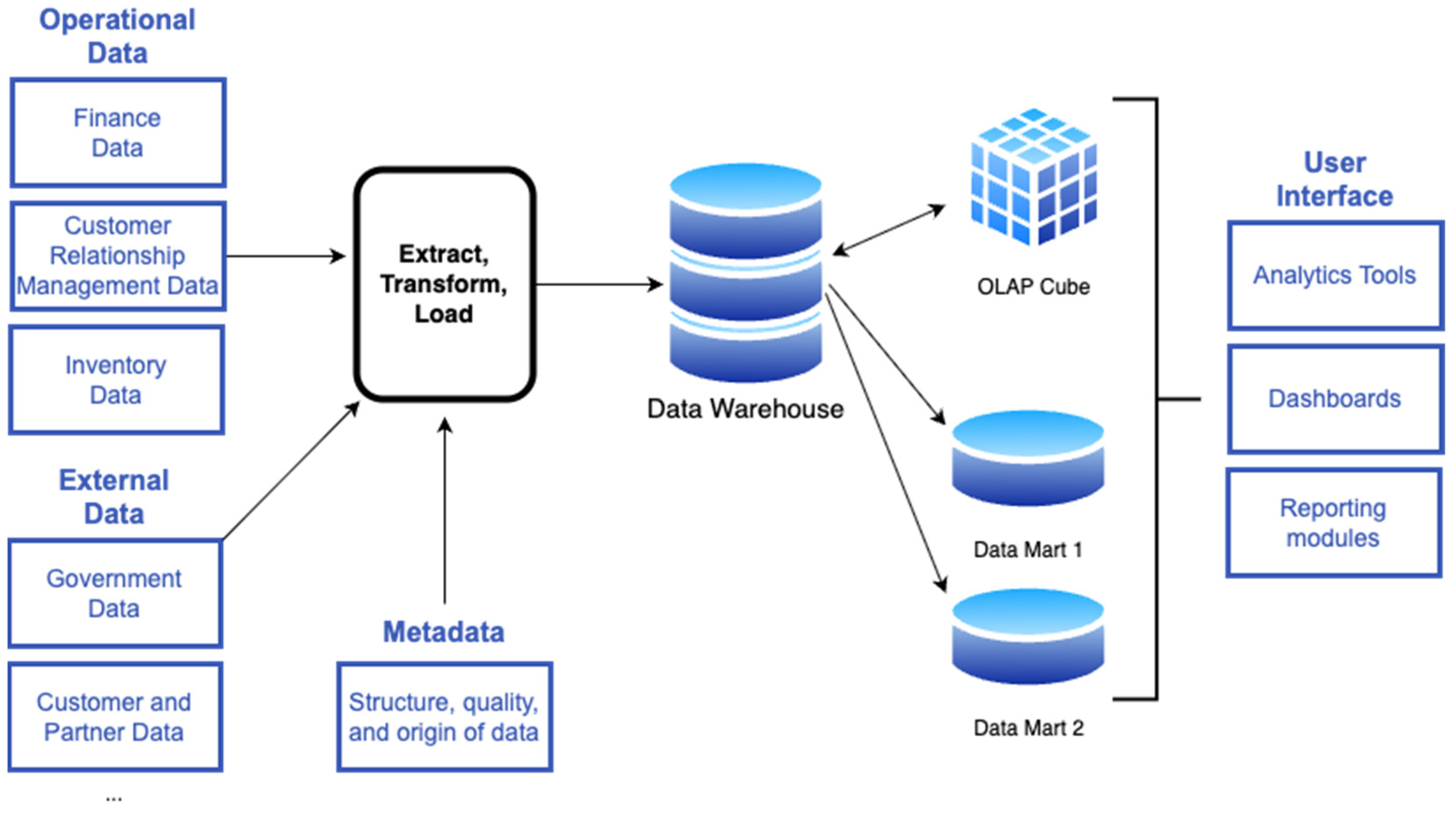
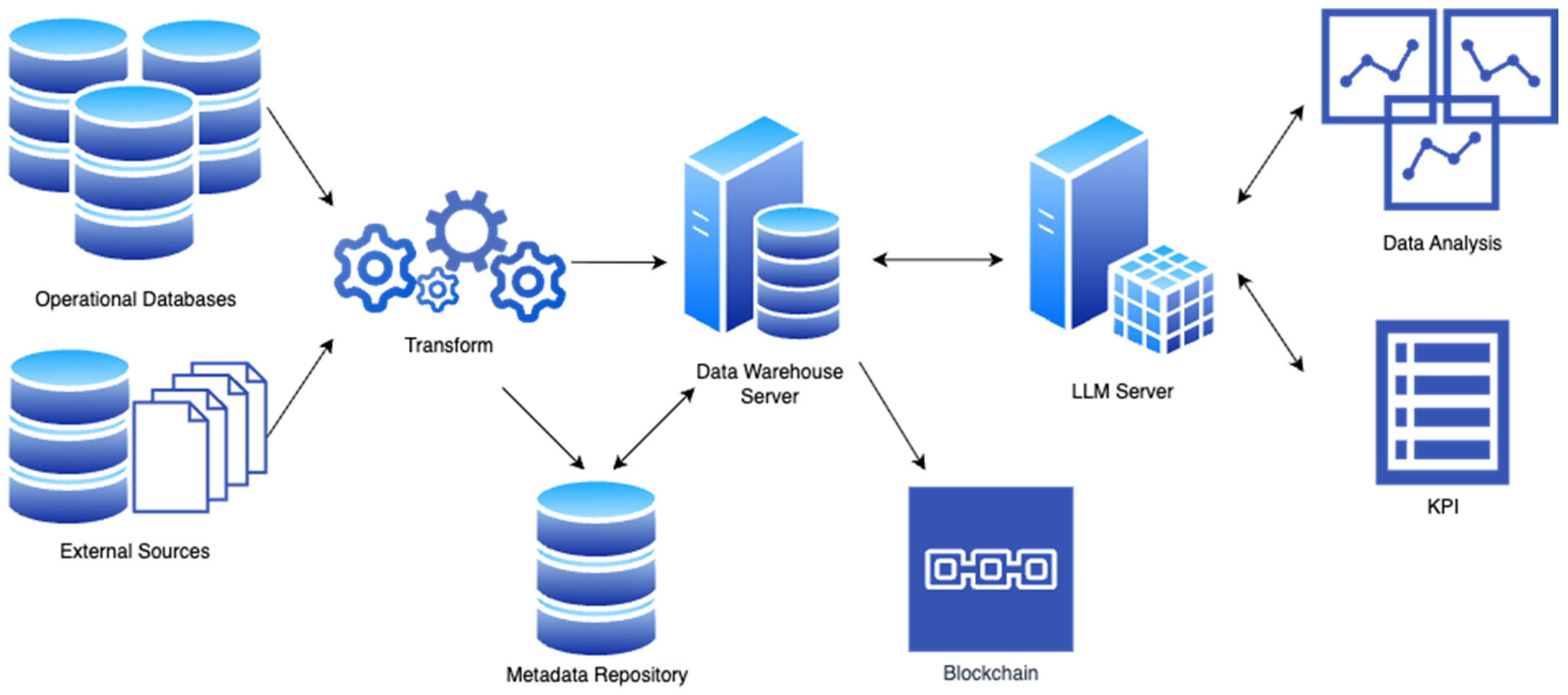

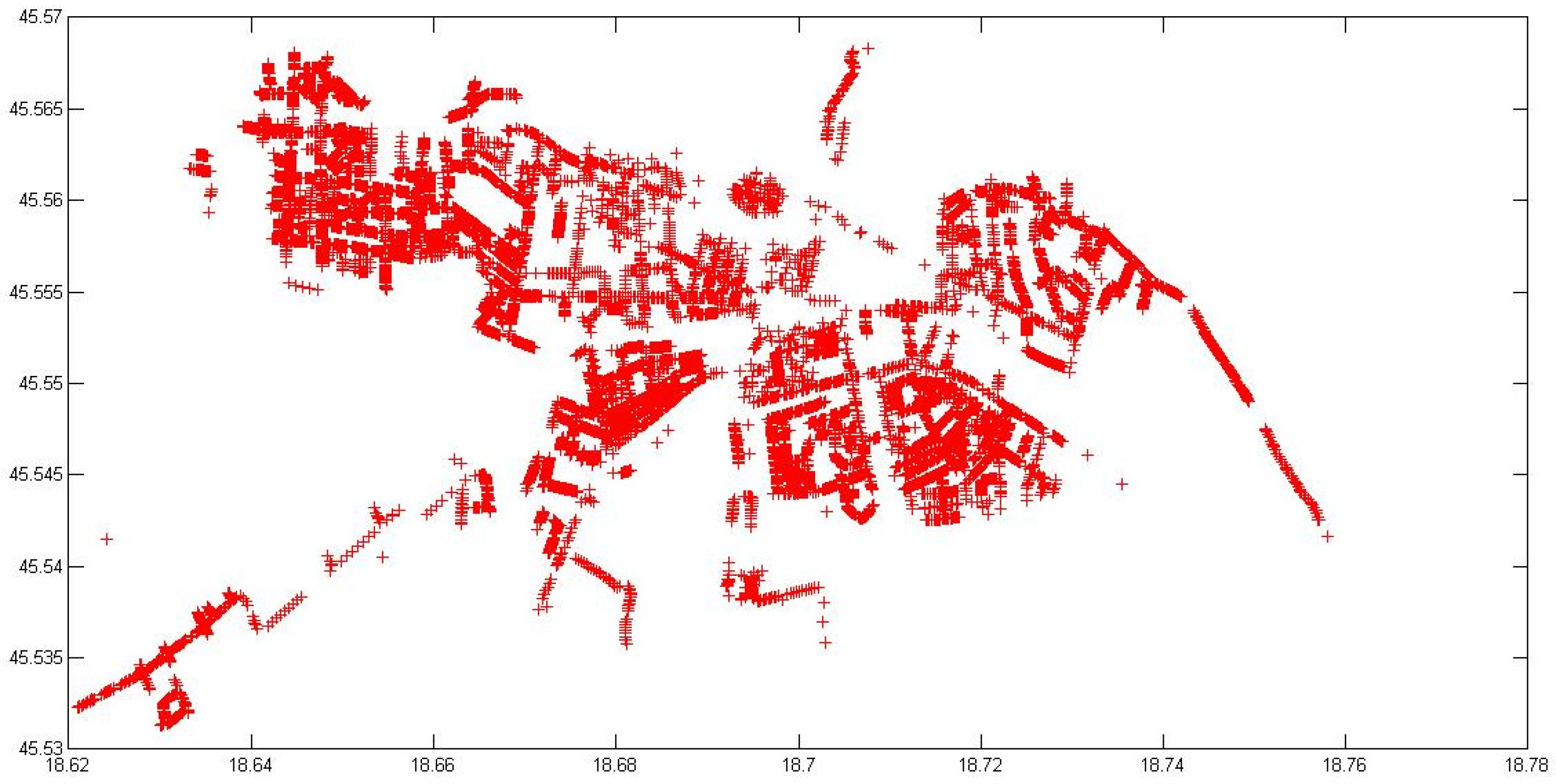
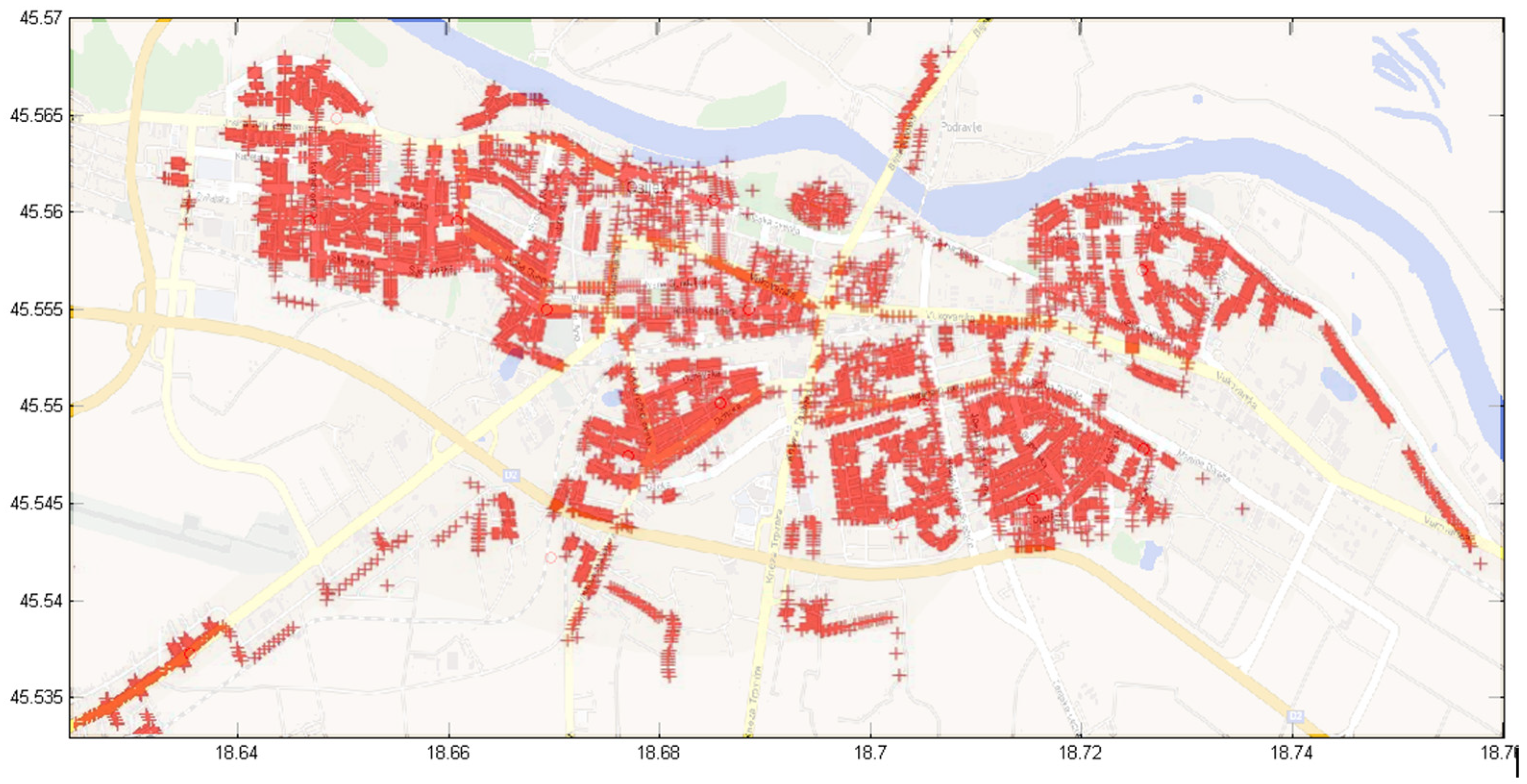
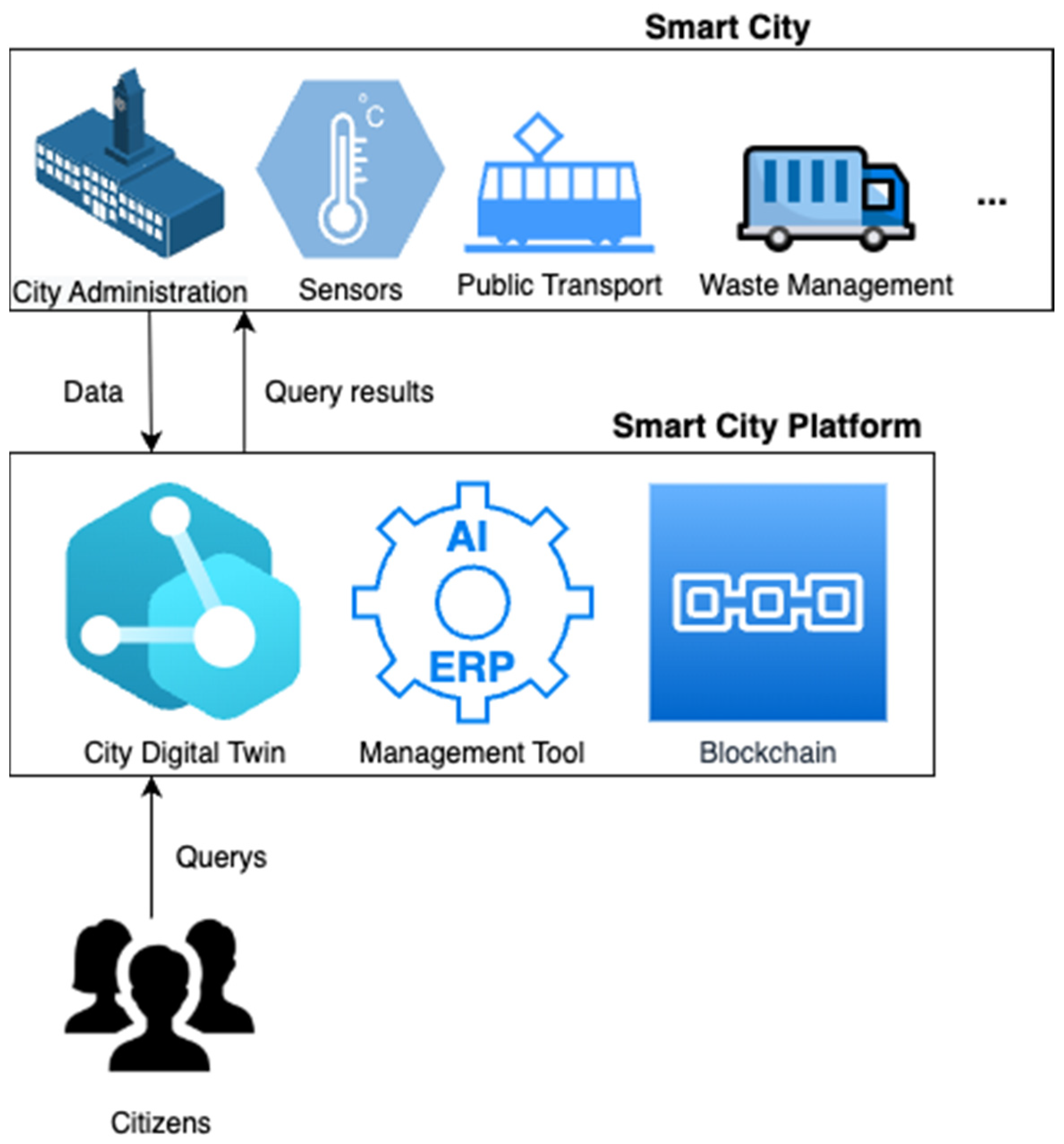
| Feature | Traditional Models | Recent Integrated Models | Proposed Platform |
|---|---|---|---|
| Digital Twin Scope | Domain-specific, siloed | Multi-domain, limited integration | Unified, real-time, cross-domain |
| Blockchain Use | Audit trails, transactions | Data provenance, some participatory tools | End-to-end integrity, participatory governance |
| AI Integration | Standalone analytics | Predictive analytics, not fully coupled | Embedded in ETL, scenario simulation |
| Data Interoperability | Low-moderate | Improving, but still challenging | High, via modular/open APIs |
| Citizen Engagement | Limited, portal-based | Some participatory pilots | Blockchain-enabled, auditable |
| Feature | Traditional ETL | Proposed ML-Enhanced ETL |
|---|---|---|
| Transformation | Rule-based, manual scripting, static transformations. | ML-driven automation predicts optimal transformations, detect anomalies, and impute missing values dynamically. |
| Scalability | Limited to on-premise infrastructure; batch-oriented. | Cloud-native leverages modular architectures for elastic scaling. |
| Data Quality | Manual error detection, reactive fixes. | Proactive quality control due to ML models has anomaly data detection. |
| Processing Speed | Hours/days for large datasets. | Real-time capabilities enabled near-instantaneous processing of streaming data via AI/ML. |
| Cost Efficiency | High upfront infrastructure costs. | Cloud services reduce operational costs. |
| Feature | Hyperledger Fabric | Hyperledger Besu | Corda |
|---|---|---|---|
| Blockchain type | Permissioned | Permissioned or Public | Permissioned (Peer-to-peer) |
| Architecture | Modular, Layered | Ethereum compatible | Notary network using DHT for peer-to-peer transactions |
| Consensus | Kafka, Raft, Solo, BFT variants | IBFT, QBFT, PoA, PoW | Notary service (Ensures transaction uniqueness and finality) |
| Smart contracts | Chaincode (Go, JavaScript, TypeScript) | Solidity (Ethereum EVM) | CorDapps (Kotlin, Java) |
| Transaction finalization | Very fast (no mining) | Depends on the consensus mechanism (slower with PoW) | Fast (transactions are final upon confirmation) |
| Privacy support | Private channels and Collection Policies | Private transactions are enabled via Tessera | Strictly enforced transaction privacy |
| Application area | Supply chain management, logistics, and healthcare | Enterprise Ethereum, fintech, banking | Banking, insurance, and financial services |
| Interoperability | supports interoperability with other blockchains | Compatible with Ethereum networks | Restricted interoperability with other blockchain networks |
Disclaimer/Publisher’s Note: The statements, opinions and data contained in all publications are solely those of the individual author(s) and contributor(s) and not of MDPI and/or the editor(s). MDPI and/or the editor(s) disclaim responsibility for any injury to people or property resulting from any ideas, methods, instructions or products referred to in the content. |
© 2025 by the authors. Licensee MDPI, Basel, Switzerland. This article is an open access article distributed under the terms and conditions of the Creative Commons Attribution (CC BY) license (https://creativecommons.org/licenses/by/4.0/).
Share and Cite
Lukić, I.; Köhler, M.; Krpić, Z.; Švarcmajer, M. Advancing Smart City Sustainability Through Artificial Intelligence, Digital Twin and Blockchain Solutions. Technologies 2025, 13, 300. https://doi.org/10.3390/technologies13070300
Lukić I, Köhler M, Krpić Z, Švarcmajer M. Advancing Smart City Sustainability Through Artificial Intelligence, Digital Twin and Blockchain Solutions. Technologies. 2025; 13(7):300. https://doi.org/10.3390/technologies13070300
Chicago/Turabian StyleLukić, Ivica, Mirko Köhler, Zdravko Krpić, and Miljenko Švarcmajer. 2025. "Advancing Smart City Sustainability Through Artificial Intelligence, Digital Twin and Blockchain Solutions" Technologies 13, no. 7: 300. https://doi.org/10.3390/technologies13070300
APA StyleLukić, I., Köhler, M., Krpić, Z., & Švarcmajer, M. (2025). Advancing Smart City Sustainability Through Artificial Intelligence, Digital Twin and Blockchain Solutions. Technologies, 13(7), 300. https://doi.org/10.3390/technologies13070300






